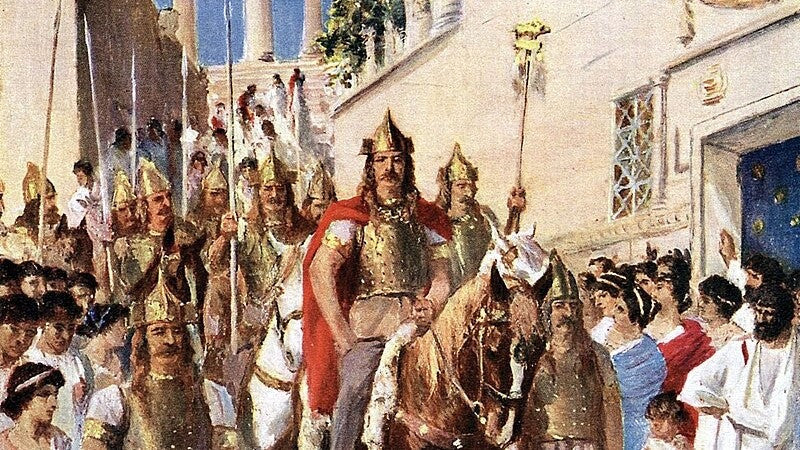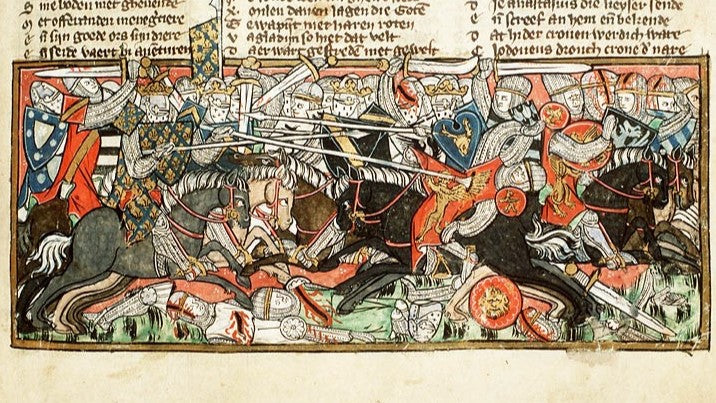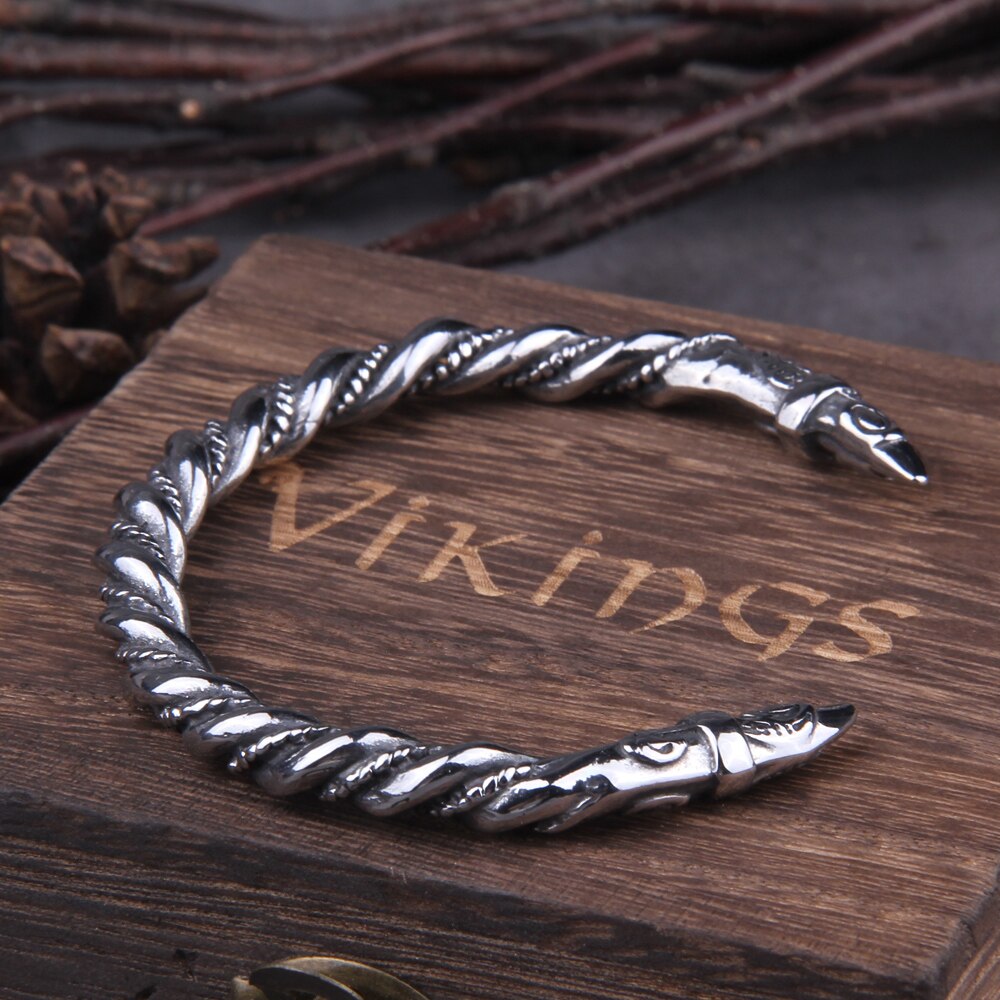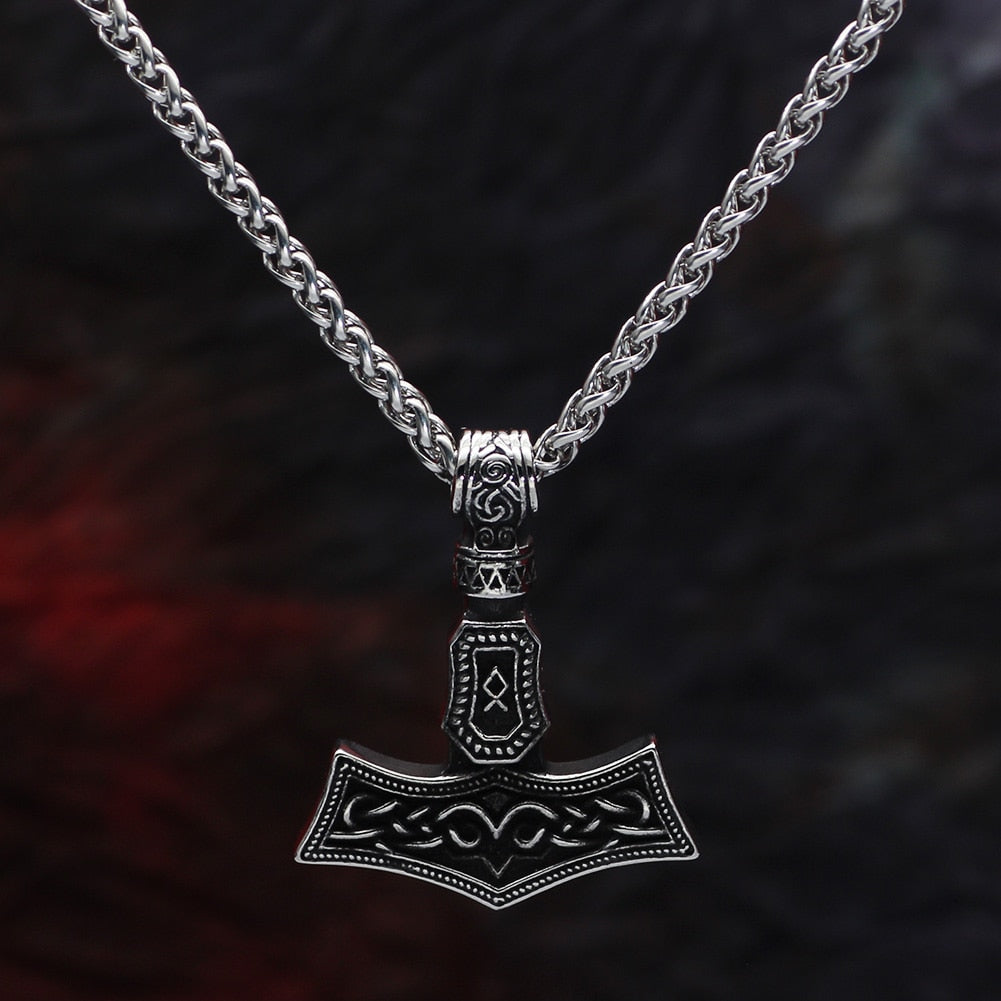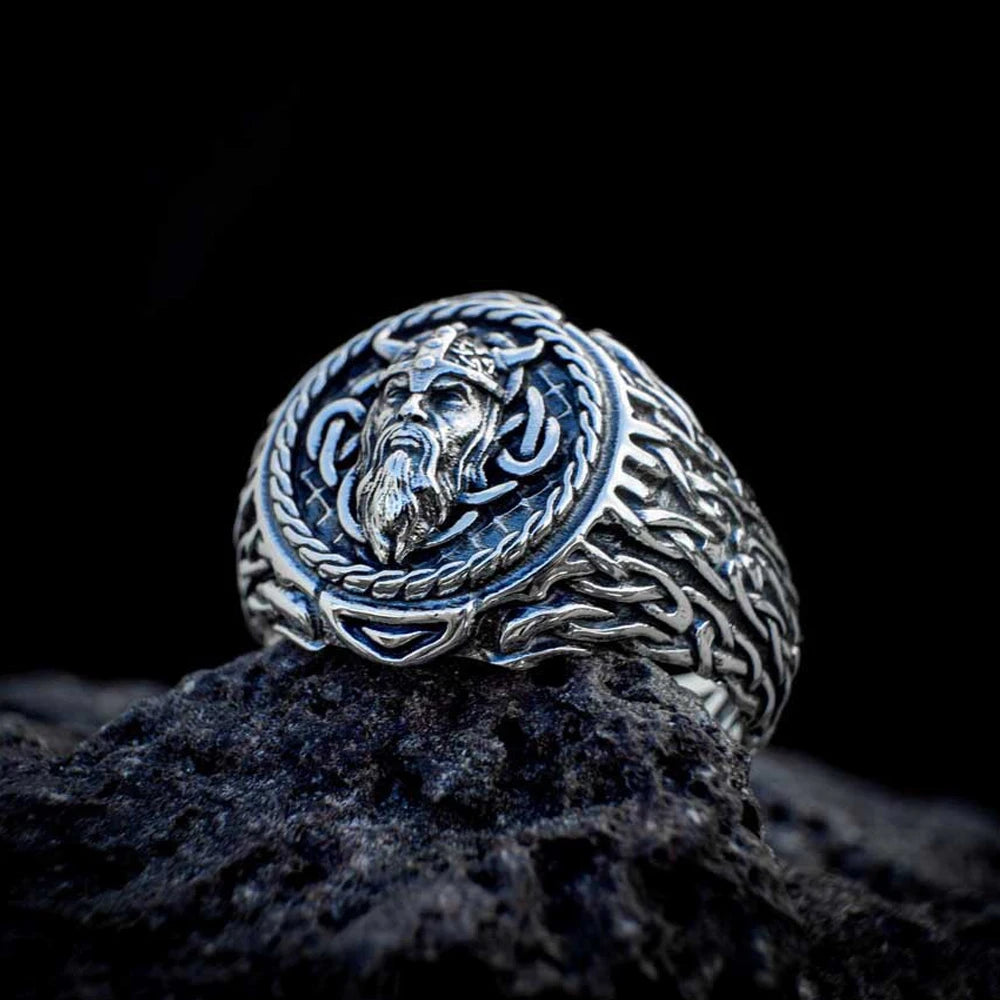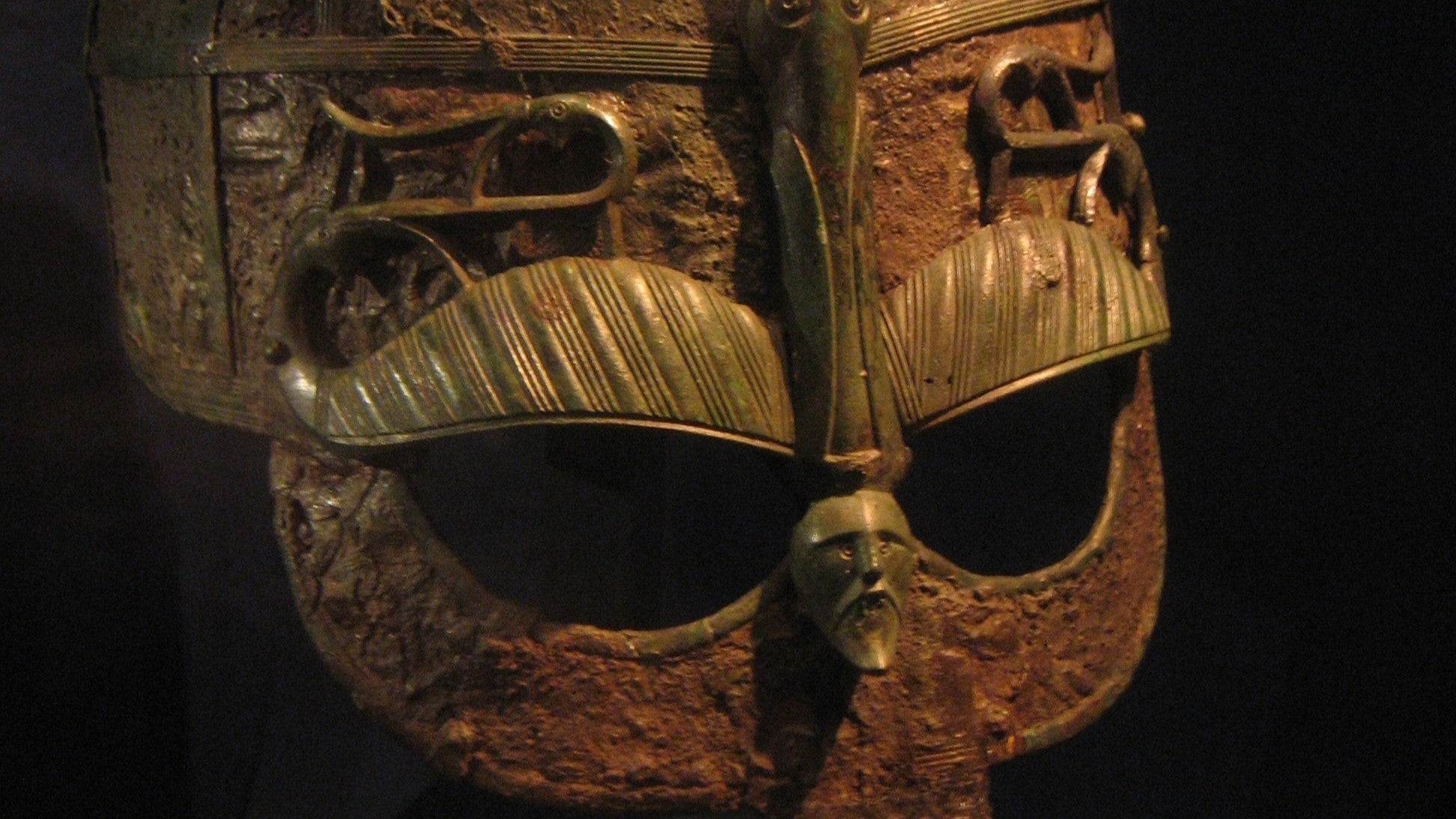
Warrior Kings and Ship Burials: Inside Sweden’s Vendel Period
Long before the Viking longships cut through the cold Atlantic, Scandinavia experienced a cultural flourishing that laid the groundwork for what would become the Norse world. Known as the Vendel Period (c. 540–790 CE), this era bridged the Migration Period and the Viking Age. It was a time of elite warrior culture, vibrant material expression, and expanding external influence. Centered in what is now east-central Sweden, the Vendel Period offers a richly documented archaeological window into early Norse aristocracy, religion, and society. Though often overshadowed by the Vikings, the Vendel elite were their direct precursors—innovators of warfare, maritime power, and mythic identity.
Origins and Chronology of the Vendel Period

A 7th-century warrior equipped with authentic spear and shield, portrayed by historical reenactment group Weorod, with members of the Jorvik Vikings in the background (Photo: WyrdLight.com).
Archaeological Definition
The term "Vendel Period" derives from rich burial finds excavated at Vendel parish in Uppland, Sweden. Along with similar graves at Valsgärde and Tuna Alsike, these finds revealed ornate helmets, weaponry, and ships that defined an entire cultural era. Swedish archaeologists first used the term in the early 20th century to describe a distinct material culture situated between the Late Migration Period and the Viking Age. The absence of contemporary written sources means much of what we know comes from archaeology.
Dating and Geographic Scope
Scholars generally date the Vendel Period from roughly 540 CE to the beginning of the Viking Age around 790 CE. It is primarily associated with the Lake Mälaren region in Sweden, especially Uppland, though cultural parallels appear across Scandinavia. This period coincides with Europe’s Merovingian era and precedes the Carolingian consolidation in the West.
Society and Power Structures

Horned helmets with bird-headed terminals, dating to the Migration Period (400–550 CE) and Vendel Era (550–800 CE), appear in elite burials and art across Northern Europe. These stylized horns, found on items like the Sutton Hoo helmet, likely held symbolic meaning—possibly linked to ritual, myth, or divine protection.
Elite Warrior Class
Vendel society was dominated by a warrior aristocracy who displayed their status in death as much as in life. Chieftains commanded household retinues or druzhinas, similar to the comitatus structure in early Germanic societies. These warbands were tightly bonded to their leaders and rewarded with gifts of weapons, silver, and prestige. The grave goods found in Vendel and Valsgärde illustrate a class of elite horsemen and seafarers with access to exquisite armor and foreign luxury goods.
Kingship and Hierarchy
While not yet “kings” in the medieval European sense, Vendel-period rulers held ritualized, sacral power rooted in pre-Christian traditions. These leaders were likely seen as mediators between gods and people. Evidence suggests that clan-based rule and sacral kingship were already developing, with genealogies traced through divine ancestors—a tradition later mirrored in Ynglingatal and Snorri Sturluson’s works.
Material Culture and Burial Practices

Vendel-era helmet plate from Sweden depicting Odin on horseback with spear and shield, flanked by ravens and facing a serpent.
Boat Graves at Vendel and Valsgärde
The most iconic feature of the Vendel Period is the boat grave, where elite individuals were interred in full-sized ships with armor, animals, and weaponry. The Valsgärde boat burials, spanning from the late 6th to early 11th centuries, display continuity in elite practices. These funerals symbolized not only the status of the deceased but also the mythic journey to the afterlife. Similar burials, such as at Sutton Hoo in East Anglia, reflect shared aristocratic culture between Scandinavia and Anglo-Saxon England.
Helmets, Weapons, and Regalia
Vendel-period helmets are among the most ornate in Europe. Featuring domed caps with embossed plaques, boar motifs, and protective spectacles, they symbolized both martial function and mythic iconography. Many helmets resemble those found at Sutton Hoo, underscoring cultural ties across the North Sea. Weapons such as pattern-welded swords, gilded scabbards, and shield bosses indicate an advanced metallurgical tradition and a social order built on martial prowess.

Ornamented iron fragments from the Vendel XIV grave (Photo: Hjalmer Stolpe).
Influence on Later Norse Art
The so-called "Vendel style" of animal ornamentation—interlace patterns, gripping beasts, and elongated bodies—predates and influences later Viking art styles such as Oseberg and Borre. These artistic traditions persisted across generations and were integral to both secular and sacred artifacts, from shields to pendants.
Trade, Warfare, and External Contacts

Double-edged sword from Grave I at Vendel, Uppland, Sweden (550–800 CE), with a gilded bronze hilt inlaid with garnets, silver, and niello animal motifs. Reconstructed scabbard. (Photo: Swedish Historiska Museet CC BY 4.0)
Contact with the Merovingians
The presence of glassware, garnets, and Frankish swords in Vendel graves suggests vibrant contact with Merovingian Gaul. Scholars such as Neil Price and Else Roesdahl note that the Vendel elite were part of a northern aristocratic network that spanned the Baltic and North Sea. They were likely involved in both raiding and gift-exchange diplomacy with the Franks and Anglo-Saxons.
The Baltic Sea Trade Routes
Scandinavian control of the Baltic Sea trade became especially important during this time. Archaeological finds from Gotland, Bornholm, and the Mälaren Valley indicate extensive maritime networks linking Scandinavia with Finland, Estonia, and even Slavic territories. Amber, iron, furs, and slaves were likely major commodities.
Eastern Influence and Steppe Styles
Some weapon styles and horse trappings found in Vendel burials bear Eastern steppe influences, likely filtered through contact with the Avars or through Slavic intermediaries. This is most evident in the horse equipment, which includes lamellar armor and elaborate bridles—elements more common on the Eurasian steppe than in Western Europe.
Religion, Myth, and Oral Tradition

Åker hoard from Hedmarken, Norway, dated to around 575 CE. First uncovered in the 19th century, with 60 more objects found in 1992, this Vendel Period hoard includes richly decorated items likely linked to a high-status warrior elite (Photo: Swedish Historiska Museet CC BY-SA 4.0).
Mythic Imagery in Grave Goods
Religious symbolism is interwoven into Vendel-period war gear. The boar, often depicted on helmets and crested mounts, was associated with Freyr and fertility. Other iconography includes mythic scenes resembling later depictions of the Valkyries and Odin’s warriors, suggesting an early visual mythology already in circulation.
Runes and the Role of the Spoken Word
While rune stones are rare in this period, early Elder Futhark inscriptions have been found on tools and personal items. The spoken word, however, carried greater cultural weight. Bards, known as skaldar, likely preserved oral histories, genealogies, and religious lore through chant and poetry—roles later mythically attributed to Odin himself.
Legacy and Transition into the Viking Age

Warrior helmet found in the Valsgärde boat grave 8 (Photo: Joe Mabel CC BY-SA 4.0).
Cultural Transmission to Viking Society
Many Vendel institutions, from warrior bands to maritime burial practices, directly influenced Viking Age culture. The warrior elite of the Vendel period evolved into the hersar and jarlar of the Viking Age. Vendel’s mythic warrior ideals persisted in sagas, and its material aesthetics were refined into Viking artistic traditions.
The Sagas and Mythic Memory
Although written centuries later, the Icelandic sagas often reflect an idealized vision of the Vendel and early Viking periods. The heroic ethos of characters such as Sigurðr or Hrólfr Kraki may have originated in Vendel-era oral traditions. The continuity of myth, ritual, and social structure between these eras reinforces the Vendel Period’s status as a cultural forerunner.
Conclusion
The Vendel Period represents a defining chapter in early Scandinavian history. Rooted in a richly aristocratic warrior culture, it fostered the artistic, religious, and political structures that would shape the Viking Age. While lesser known than the Vikings, the Vendel elite wielded power, engaged in transcontinental trade, and developed an enduring mythic identity. Their ship burials, warrior iconography, and sacral kingship reveal a people who viewed life and death through a heroic lens. Far from a dark age, the Vendel Period stands as a golden age of pre-Viking Norse civilization—evident in every forged blade, buried ship, and carved animal motif left behind.
Frequently Asked Questions (FAQs)
What is the Vendel Period?
The Vendel Period refers to a phase in Scandinavian history from roughly 540 to 790 CE, characterized by elite warrior culture and rich burial traditions, particularly in east-central Sweden.
Where does the name "Vendel" come from?
The name comes from Vendel parish in Uppland, Sweden, where archaeologists uncovered elaborately furnished boat graves dating to this period.
How does the Vendel Period relate to the Viking Age?
The Vendel Period directly preceded and helped shape the Viking Age through its social structures, religious beliefs, and warrior ideals.
What are the most important archaeological finds from the Vendel Period?
The boat graves at Vendel and Valsgärde, featuring helmets, weapons, and ceremonial ships, are among the most significant finds.
Did the Vendel people have contact with other cultures?
Yes. They traded with Merovingian Gaul, Anglo-Saxon England, and possibly steppe cultures, as seen in their imported goods and stylistic influences.
References
Hedenstierna-Jonson, C. (2009). The Helmet from Valsgärde 8. Uppsala University.
Price, N. (2020). Children of Ash and Elm: A History of the Vikings. Basic Books.
Roesdahl, E. (1998). The Vikings. Penguin Books.
Ljungkvist, J. (2006). The Boat-graves of Valsgärde and Vendel: Chronology and Context. Uppsala University.
Gräslund, A.-S. (2007). “The Role of Boat-graves in the Late Iron Age Elite Society.” Acta Archaeologica, Vol. 78.
